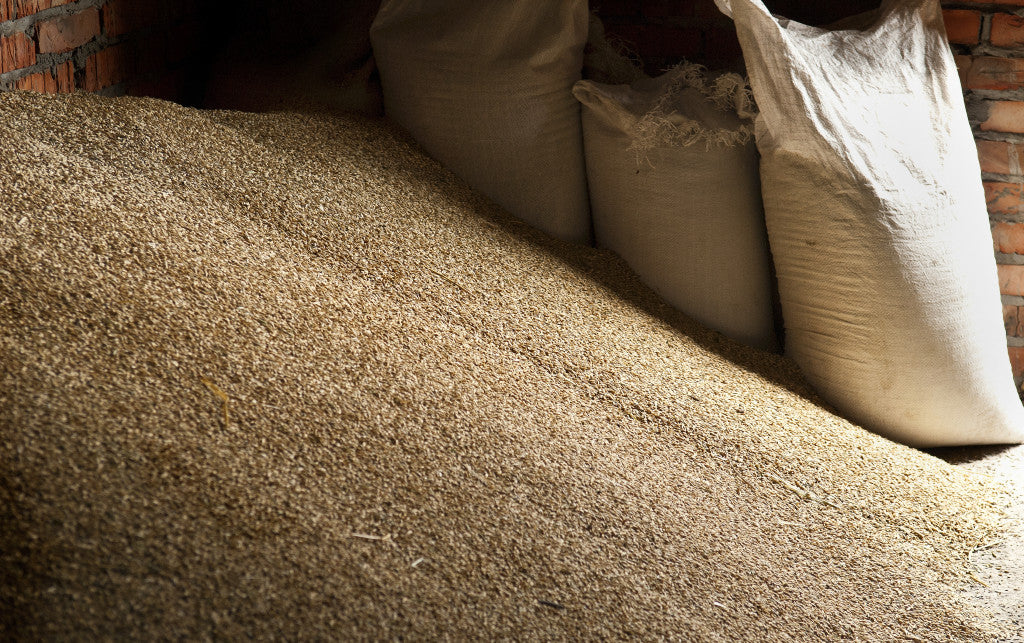By Beth Buck

Wheat is the #1 thing people think of when you mention food storage. My grandmother is such a believer in the sanctity of food storage wheat that she still has about a thousand pounds of it stored in her basement, even though she hasn't baked bread for years (N.B. this is not an exaggeration). Everybody wants to store wheat. Probably you do, too.
So you decide to buy yourself some. You go onto the handy
Emergency Essentials website, prepared to order your family's weight in wheat, when you pause. There's more than one kind of wheat. Hard red, hard white, and soft white. I just want wheat, you think to yourself. Why did people decide to make wheat complicated by having more than one kind?
Don't panic.
But don't just close your eyes and click on one of the varieties at random, either. Remember the old adage: store what you eat, eat what you store. Different varieties are good for different things. If you expect to make a lot of bread but get soft white wheat, you will Replace yourself very disappointed when your dough doesn't rise the way you think it should.
Soft wheat is much higher in moisture content than hard wheat, and has a lot less gluten. Gluten is what makes the bread-magic happen, and without it, you can make yourself some very delicious crackers or other things that don't require yeast. Soft wheat is ideal for southern-style biscuits, pancakes, and whole-wheat pie crust. If you see flour on your grocery store shelves marked “cake flour,” it likely contains flour milled from soft wheat.
Hard red wheat is what most people think of as traditional wheat. Red wheat berries have a slightly reddish tinge to them, a darker brown than white wheat. Red wheat is slightly higher in protein and high in gluten, and is used, along with white, to make bread flour. Using 100% whole wheat in your loaf will make a really dense loaf. Think of the bread the Ingalls family made from wheat ground with the coffee mill in The Long Winter – brown, with a “nutty taste.” That was made from hard red, because white wheat had not been invented yet. Even my very traditional grandmother used to make her homemade bread with 50% all-purpose flour.

Most people think that all wheat has been around for ages but that isn't actually true.
White wheat is relatively new on the agricultural scene, and was only developed within the last few decades. A lot of people like it – myself included – because the bread made from it is light and fluffy even when it's 100% whole wheat. In addition to improved bread texture, most of the white type has been bred to be a dwarf variety; the whole plant only grows to be about 18 inches tall – this allows for higher grain yields because the energy from the plant goes into the grain instead of the stalk.
While white doesn't have as much protein as red , the difference is fairly negligible. When you eat whole white wheat, you're still getting all the nutrition found in the bran and germ. Remember that all-purpose flour doesn't have these nutrients in it natively; the bran and germ are removed during production so all-purpose white flour has to be enriched if it is to have any nutritional value at all, but that is a topic for another day.
So what kind do I have in my storage? Hard white winter wheat. I make bread a lot more often than I make pie crust or biscuits, so that's what works best for me.
 Beth Buck has been involved with emergency preparedness since her very earliest years. She enjoys hiking, martial arts, reading, and writing about food storage. Beth lives in the Intermountain West with her family.
Beth Buck has been involved with emergency preparedness since her very earliest years. She enjoys hiking, martial arts, reading, and writing about food storage. Beth lives in the Intermountain West with her family.

 Wheat is the #1 thing people think of when you mention food storage. My grandmother is such a believer in the sanctity of food storage wheat that she still has about a thousand pounds of it stored in her basement, even though she hasn't baked bread for years (N.B. this is not an exaggeration). Everybody wants to store wheat. Probably you do, too.
So you decide to buy yourself some. You go onto the handy Emergency Essentials website, prepared to order your family's weight in wheat, when you pause. There's more than one kind of wheat. Hard red, hard white, and soft white. I just want wheat, you think to yourself. Why did people decide to make wheat complicated by having more than one kind?
Don't panic.
But don't just close your eyes and click on one of the varieties at random, either. Remember the old adage: store what you eat, eat what you store. Different varieties are good for different things. If you expect to make a lot of bread but get soft white wheat, you will Replace yourself very disappointed when your dough doesn't rise the way you think it should.
Soft wheat is much higher in moisture content than hard wheat, and has a lot less gluten. Gluten is what makes the bread-magic happen, and without it, you can make yourself some very delicious crackers or other things that don't require yeast. Soft wheat is ideal for southern-style biscuits, pancakes, and whole-wheat pie crust. If you see flour on your grocery store shelves marked “cake flour,” it likely contains flour milled from soft wheat.
Hard red wheat is what most people think of as traditional wheat. Red wheat berries have a slightly reddish tinge to them, a darker brown than white wheat. Red wheat is slightly higher in protein and high in gluten, and is used, along with white, to make bread flour. Using 100% whole wheat in your loaf will make a really dense loaf. Think of the bread the Ingalls family made from wheat ground with the coffee mill in The Long Winter – brown, with a “nutty taste.” That was made from hard red, because white wheat had not been invented yet. Even my very traditional grandmother used to make her homemade bread with 50% all-purpose flour.
Wheat is the #1 thing people think of when you mention food storage. My grandmother is such a believer in the sanctity of food storage wheat that she still has about a thousand pounds of it stored in her basement, even though she hasn't baked bread for years (N.B. this is not an exaggeration). Everybody wants to store wheat. Probably you do, too.
So you decide to buy yourself some. You go onto the handy Emergency Essentials website, prepared to order your family's weight in wheat, when you pause. There's more than one kind of wheat. Hard red, hard white, and soft white. I just want wheat, you think to yourself. Why did people decide to make wheat complicated by having more than one kind?
Don't panic.
But don't just close your eyes and click on one of the varieties at random, either. Remember the old adage: store what you eat, eat what you store. Different varieties are good for different things. If you expect to make a lot of bread but get soft white wheat, you will Replace yourself very disappointed when your dough doesn't rise the way you think it should.
Soft wheat is much higher in moisture content than hard wheat, and has a lot less gluten. Gluten is what makes the bread-magic happen, and without it, you can make yourself some very delicious crackers or other things that don't require yeast. Soft wheat is ideal for southern-style biscuits, pancakes, and whole-wheat pie crust. If you see flour on your grocery store shelves marked “cake flour,” it likely contains flour milled from soft wheat.
Hard red wheat is what most people think of as traditional wheat. Red wheat berries have a slightly reddish tinge to them, a darker brown than white wheat. Red wheat is slightly higher in protein and high in gluten, and is used, along with white, to make bread flour. Using 100% whole wheat in your loaf will make a really dense loaf. Think of the bread the Ingalls family made from wheat ground with the coffee mill in The Long Winter – brown, with a “nutty taste.” That was made from hard red, because white wheat had not been invented yet. Even my very traditional grandmother used to make her homemade bread with 50% all-purpose flour.
 Most people think that all wheat has been around for ages but that isn't actually true. White wheat is relatively new on the agricultural scene, and was only developed within the last few decades. A lot of people like it – myself included – because the bread made from it is light and fluffy even when it's 100% whole wheat. In addition to improved bread texture, most of the white type has been bred to be a dwarf variety; the whole plant only grows to be about 18 inches tall – this allows for higher grain yields because the energy from the plant goes into the grain instead of the stalk.
While white doesn't have as much protein as red , the difference is fairly negligible. When you eat whole white wheat, you're still getting all the nutrition found in the bran and germ. Remember that all-purpose flour doesn't have these nutrients in it natively; the bran and germ are removed during production so all-purpose white flour has to be enriched if it is to have any nutritional value at all, but that is a topic for another day.
So what kind do I have in my storage? Hard white winter wheat. I make bread a lot more often than I make pie crust or biscuits, so that's what works best for me.
Most people think that all wheat has been around for ages but that isn't actually true. White wheat is relatively new on the agricultural scene, and was only developed within the last few decades. A lot of people like it – myself included – because the bread made from it is light and fluffy even when it's 100% whole wheat. In addition to improved bread texture, most of the white type has been bred to be a dwarf variety; the whole plant only grows to be about 18 inches tall – this allows for higher grain yields because the energy from the plant goes into the grain instead of the stalk.
While white doesn't have as much protein as red , the difference is fairly negligible. When you eat whole white wheat, you're still getting all the nutrition found in the bran and germ. Remember that all-purpose flour doesn't have these nutrients in it natively; the bran and germ are removed during production so all-purpose white flour has to be enriched if it is to have any nutritional value at all, but that is a topic for another day.
So what kind do I have in my storage? Hard white winter wheat. I make bread a lot more often than I make pie crust or biscuits, so that's what works best for me.
 Beth Buck has been involved with emergency preparedness since her very earliest years. She enjoys hiking, martial arts, reading, and writing about food storage. Beth lives in the Intermountain West with her family.
Beth Buck has been involved with emergency preparedness since her very earliest years. She enjoys hiking, martial arts, reading, and writing about food storage. Beth lives in the Intermountain West with her family.



1 comment
James Marusek
I personally like Spelt which also known as dinkel wheat or hulled wheat, is a species of wheat cultivated since approximately 5000 BC. It has a nutty flavor that produces a very rich taste to breads.